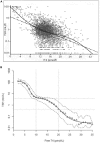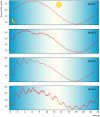Homeostatic Control of the Thyroid-Pituitary Axis: Perspectives for Diagnosis and Treatment - PubMed (original) (raw)
Review
Homeostatic Control of the Thyroid-Pituitary Axis: Perspectives for Diagnosis and Treatment
Rudolf Hoermann et al. Front Endocrinol (Lausanne). 2015.
Abstract
The long-held concept of a proportional negative feedback control between the thyroid and pituitary glands requires reconsideration in the light of more recent studies. Homeostatic equilibria depend on dynamic inter-relationships between thyroid hormones and pituitary thyrotropin (TSH). They display a high degree of individuality, thyroid-state-related hierarchy, and adaptive conditionality. Molecular mechanisms involve multiple feedback loops on several levels of organization, different time scales, and varying conditions of their optimum operation, including a proposed feedforward motif. This supports the concept of a dampened response and multistep regulation, making the interactions between TSH, FT4, and FT3 situational and mathematically more complex. As a homeostatically integrated parameter, TSH becomes neither normatively fixed nor a precise marker of euthyroidism. This is exemplified by the therapeutic situation with l-thyroxine (l-T4) where TSH levels defined for optimum health may not apply equivalently during treatment. In particular, an FT3-FT4 dissociation, discernible FT3-TSH disjoint, and conversion inefficiency have been recognized in l-T4-treated athyreotic patients. In addition to regulating T4 production, TSH appears to play an essential role in maintaining T3 homeostasis by directly controlling deiodinase activity. While still allowing for tissue-specific variation, this questions the currently assumed independence of the local T3 supply. Rather it integrates peripheral and central elements into an overarching control system. On l-T4 treatment, altered equilibria have been shown to give rise to lower circulating FT3 concentrations in the presence of normal serum TSH. While data on T3 in tissues are largely lacking in humans, rodent models suggest that the disequilibria may reflect widespread T3 deficiencies at the tissue level in various organs. As a consequence, the use of TSH, valuable though it is in many situations, should be scaled back to a supporting role that is more representative of its conditional interplay with peripheral thyroid hormones. This reopens the debate on the measurement of free thyroid hormones and encourages the identification of suitable biomarkers. Homeostatic principles conjoin all thyroid parameters into an adaptive context, demanding a more flexible interpretation in the accurate diagnosis and treatment of thyroid dysfunction.
Keywords: TSH; deiodinase; feedback regulation; homeostasis; set point; thyroid hormones.
Figures
Figure 1
Homeostatic integration of central, thyroidal, and peripheral influences. The integrated control involves several major control loops, a negative feedback control of thyroid hormones on pituitary TSH and hypothalamic TRH, positive stimulatory control of TRH on TSH, ultrashort feedback of TSH on its own secretion, and feedforward control of deiodinases by TSH. Other thyrotropic agonists than TSH, such as TSH receptor antibodies (TSH-R Ab) and human chorionic gonadotropin (hCG), play an important role in diseases, such as Graves’ disease and pregnancy-related hyperthyroidism. A plethora of additional influences may fine-tune the responses at each level of organization. 1 refers to the classical Astwood–Hoskins loop, and 5 indicates ultrashort feedback loop of TSH on its own secretion, described in the text. Additional feedback loops (not shown here) control the binding of thyroid hormones to plasma proteins (8, 10).
Figure 2
Non-linear relationship between logTSH and free T4. The two studies by Hoermann et al. (6) (A) and Hadlow et al. (7) (B) show that the TSH–FT4 relationship may not follow a proportional log-linear model (dashed straight line), displaying a damped response in the euthyroid range and steeper gradients at the hypothyroid or hyperthyroid spectrum. The superiority of the non-linear modulatory logistic function shown over the standard log-linear model was statistically established by a strict curve-fitting template based on Akaike’s information criterion (6). A multistep regulation of the FT4–TSH feedback control is discussed in the text. Adapted and reproduced with permission from Hoermann et al. (6) and Hadlow et al. (7).
Figure 3
Pulsatility of TSH secretion. Secretion of thyrotropin is subject to circadian and ultradian variation. Shown are results of computer simulations with circadian input only (model 1), additional stochastic afferences (model 2), additional ultrashort feedback of TSH secretion (model 3), and combined stochastic input and ultrashort feedback (model 4). Statistical properties and fractal geometry of model 4 is identical to that of natural time series, while the simpler models differ (10).
Figure 4
Overview of classical (iodothyronines) and non-classical thyroid hormones (iodothyroacetates and thyronamines) with associated interconversion processes. Adapted from Engler and Burger (152), Piehl et al. (153), Soffer et al. (154), and Hoefig et al. (155).
Figure 5
Loss of T3 stability in l-T4-treated athyreotic patients with thyroid carcinomas. In controls (dashed line), serum T3 remains stable over a wide variation in the endogenous thyroid hormone production. In contrast, in
l
-T4-treated patients (solid line), compensatory T3 regulation is broken, and serum T3 unstably varies with the exogenous T4 supply. Adapted and reproduced with permission from Hoermann et al. (123).
References
- Garber JR, Cobin RH, Gharib H, Hennessey JV, Klein I, Mechanick JI, et al. Woeber for the American Association of Clinical Endocrinologists and American Thyroid Association Taskforce on hypothyroidism in adults KA. Clinical practice guidelines for hypothyroidism in adults: cosponsored by the American Association of Clinical Endocrinologists and the American Thyroid Association. Thyroid (2012) 22:1200–35.10.1089/thy.2012.0205 - DOI - PubMed
Publication types
LinkOut - more resources
Full Text Sources
Other Literature Sources
Medical
Research Materials




